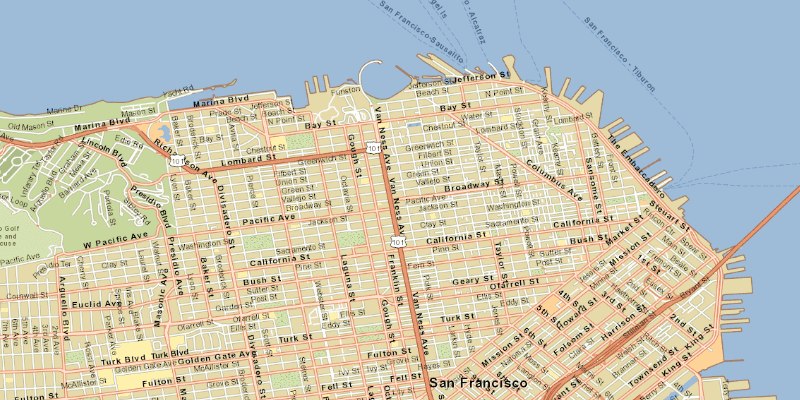Load an offline copy of a tiled map service as a basemap.

Use case
Constructing an ArcGISTiledLayer from a local tile package (.tpk & .tpkx), allows you to use that basemap tiled service when the application is offline. Dividing a raster into tiles allows the map to provide relevant tiles and level of detail to the user when panning and zooming. For example, when working in an environment that has no connectivity, this could provide access to a map for navigating your surroundings.
How to use the sample
Launch the sample to view the "San Francisco offline tile package" as the basemap.
How it works
- Create a
TileCache, specifying the path to the local tile package. - Create an
ArcGISTiledLayerwith the tile cache. - Create a
Basemapwith the tiled layer. - Create an
ArcGISMapwith the basemap and set it to a MapView.
Relevant API
- ArcGISMap
- ArcGISTiledLayer
- Basemap
- TileCache
About the data
The map opens to a view of the city of San Francisco, CA. In a disconnected environment, this basemap tile service would be fully accessible to zoom and pan as if you were connected to a online service.
Additional information
ArcGISTiledLayer and TileCache supports both .tpk and .tpkx file formats.
Tags
cache, layers, offline, tile
Sample Code
/*
* Copyright 2017 Esri.
*
* Licensed under the Apache License, Version 2.0 (the "License"); you may not
* use this file except in compliance with the License. You may obtain a copy of
* the License at
*
* http://www.apache.org/licenses/LICENSE-2.0
*
* Unless required by applicable law or agreed to in writing, software
* distributed under the License is distributed on an "AS IS" BASIS, WITHOUT
* WARRANTIES OR CONDITIONS OF ANY KIND, either express or implied. See the
* License for the specific language governing permissions and limitations under
* the License.
*/
package com.esri.samples.tile_cache;
import javafx.application.Application;
import javafx.scene.Scene;
import javafx.scene.layout.StackPane;
import javafx.stage.Stage;
import com.esri.arcgisruntime.data.TileCache;
import com.esri.arcgisruntime.layers.ArcGISTiledLayer;
import com.esri.arcgisruntime.mapping.ArcGISMap;
import com.esri.arcgisruntime.mapping.Basemap;
import com.esri.arcgisruntime.mapping.view.MapView;
import java.io.File;
public class TileCacheSample extends Application {
private MapView mapView;
@Override
public void start(Stage stage) {
try {
// create stack pane and application scene
StackPane stackPane = new StackPane();
Scene scene = new Scene(stackPane);
// set title, size, and add scene to stage
stage.setTitle("Tile Cache Sample");
stage.setWidth(800);
stage.setHeight(700);
stage.setScene(scene);
stage.show();
// create a tile cache from a local tile package
File tpkFile = new File(System.getProperty("data.dir"), "./samples-data/sanfrancisco/SanFrancisco.tpk");
TileCache tileCache = new TileCache(tpkFile.getAbsolutePath());
// create a tiled layer from the tile cache
ArcGISTiledLayer tiledLayer = new ArcGISTiledLayer(tileCache);
// create a basemap with the tiled layer
Basemap basemap = new Basemap(tiledLayer);
// create ArcGISMap with the tiled layer basemap
ArcGISMap map = new ArcGISMap(basemap);
// create a map view and set its map
mapView = new MapView();
mapView.setMap(map);
// add map view to stack pane
stackPane.getChildren().add(mapView);
} catch (Exception e) {
// on any error, print the stack trace
e.printStackTrace();
}
}
/**
* Stops and releases all resources used in application.
*/
@Override
public void stop() {
if (mapView != null) {
mapView.dispose();
}
}
/**
* Opens and runs application.
*
* @param args arguments passed to this application
*/
public static void main(String[] args) {
Application.launch(args);
}
}